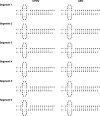Upolu virus and Aransas Bay virus, two presumptive bunyaviruses, are novel members of the family Orthomyxoviridae
- PMID: 24574415
- PMCID: PMC4019087
- DOI: 10.1128/JVI.03391-13
Upolu virus and Aransas Bay virus, two presumptive bunyaviruses, are novel members of the family Orthomyxoviridae
Abstract
Emerging and zoonotic pathogens pose continuing threats to human health and ongoing challenges to diagnostics. As nucleic acid tests are playing increasingly prominent roles in diagnostics, the genetic characterization of molecularly uncharacterized agents is expected to significantly enhance detection and surveillance capabilities. We report the identification of two previously unrecognized members of the family Orthomyxoviridae, which includes the influenza viruses and the tick-transmitted Thogoto and Dhori viruses. We provide morphological, serologic, and genetic evidence that Upolu virus (UPOV) from Australia and Aransas Bay virus (ABV) from North America, both previously considered potential bunyaviruses based on electron microscopy and physicochemical features, are orthomyxoviruses instead. Their genomes show up to 68% nucleotide sequence identity to Thogoto virus (segment 2; ∼74% at the amino acid level) and a more distant relationship to Dhori virus, the two prototype viruses of the recognized species of the genus Thogotovirus. Despite sequence similarity, the coding potentials of UPOV and ABV differed from that of Thogoto virus, instead being like that of Dhori virus. Our findings suggest that the tick-transmitted viruses UPOV and ABV represent geographically distinct viruses in the genus Thogotovirus of the family Orthomyxoviridae that do not fit in the two currently recognized species of this genus.
Importance: Upolu virus (UPOV) and Aransas Bay virus (ABV) are shown to be orthomyxoviruses instead of bunyaviruses, as previously thought. Genetic characterization and adequate classification of agents are paramount in this molecular age to devise appropriate surveillance and diagnostics. Although more closely related to Thogoto virus by sequence, UPOV and ABV differ in their coding potentials by lacking a proposed pathogenicity factor. In this respect, they are similar to Dhori virus, which, despite the lack of a pathogenicity factor, can cause disease. These findings enable further studies into the evolution and pathogenicity of orthomyxoviruses.
Figures




 , in tick-borne viruses and AcMNPV except DHOV
, in tick-borne viruses and AcMNPV except DHOV  , or in thogoto- and dhoriviruses or in thogotoviruses and AcMNPV
, or in thogoto- and dhoriviruses or in thogotoviruses and AcMNPV  ; conserved glycosylation sites surrounding position 183 (N183GS/N183GT; N197VT in AcMNPV) and position 415/428 (NxT/S, including N415/412/410XT/S in UPOV, ABV, and JOSV; N428/427/423/416XT/S in UPOV, ABV, JOSV, and THOV; N378NT in THOV; N396HS in DHOV; N422VS in QRFV; and N384NS/N426TT in AcMNPV); the trans-membrane anchor (TM); and amino acids of the cytoplasmic tail region (Cyt-tail).
; conserved glycosylation sites surrounding position 183 (N183GS/N183GT; N197VT in AcMNPV) and position 415/428 (NxT/S, including N415/412/410XT/S in UPOV, ABV, and JOSV; N428/427/423/416XT/S in UPOV, ABV, JOSV, and THOV; N378NT in THOV; N396HS in DHOV; N422VS in QRFV; and N384NS/N426TT in AcMNPV); the trans-membrane anchor (TM); and amino acids of the cytoplasmic tail region (Cyt-tail).
References
-
- Doherty RL, Whitehead RH, Wetters EJ. 1968. Isolation of viruses from Ornithodoros capensis Neumann from a tern colony on the Great Barrier Reef, North Queensland. Aust. J. Sci. 31:363–364
-
- Yunker CE, Clifford CM, Keirans JE, Thomas LA, Rice RCA. 1979. Aransas Bay virus, a new arbovirus of the Upolu serogroup from Ornithodoros capensis (Acari: Argasidae) in costal Texas. J. Med. Entomol. 16:453–460
-
- Carley JG, Standfast HA, Kay BH. 1973. Multiplication of viruses isolated from arthopods [sic] and vertebrates in Australia in experimentally infected mosquitoes. J. Med. Entomol. 10:244–249 - PubMed
Publication types
MeSH terms
Grants and funding
LinkOut - more resources
Full Text Sources
Other Literature Sources
Research Materials

